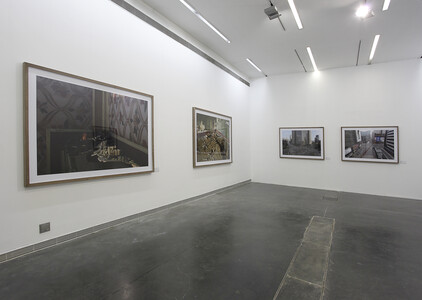Solo Exhibition UCCA, Beijing
September 5, 2009, Beijing – The Ullens Center for Contemporary Art (UCCA) will present Cheng Ran and Jiang Pengyi’s exhibition, Immersion and Distance, curated by established artist Yang Fudong. Cheng Ran will present his works Punk’s Here, which includes a ‘midnight’ museum installation and a video displayed by three screens. At the same time, Jiang Pengyi will present his photographic works, Unregistered City, Forgot the Password?, etc, all of which are stylized pictures which have been digitally altered during the post production process. The exhibition will be on display until October 31, 2009.
Initiated in July 2008, the concept of the Curated by… series was developed by UCCA Director Jérôme Sans and launched to support the creativity of young Chinese artists. The series invites leading Chinese artists to recommend and curate exhibitions of works by new talents, connecting artists of different ages, the art institution, and the public. So far, Wang Du, Wang Jianwei, Qiu Zhijie and Liu Xiaodong have curated exhibitions by Ji Zhou, He An, Ye Nan & Ding Ding, and Yan Bing, respectively; many of these exhibitions were these artists’ first solo shows. More established artists will also participate in this series as curators.
“As one of the most influential new artists in China today, Yang Fudong addresses the life of contemporary youth in a rapidly changing urban environment under the influence of globalization. It is an honor for UCCA to invite him to curate this show, including multimedia installations and photographs, which presents two gifted young artists’ critical thinking of their own life experience.” UCCA Director, Jérôme Sans “Immersion and distance may indicate insistence and a certain direction.” says Yang Fudong when explaining the theme of the exhibition. In Yang Fudong’s eyes, Jiang Pengyi’s photography is as persistent as the artist himself. A quiet and gentle man, he is immersed in the ‘real’ imagery he creates. The one-of-a-kind, sensitive and even slightly lonely nature of his works only emerges in the prolonged gaze of the audience. Cheng Ran’s works, on the other hand, are largely based on rational thinking. Rather than focusing on a certain medium, he has been working with video, poetry, theatre, fiction and installation. In his works, Cheng alters the space, structure and perception of the original materials. His intellectual approach makes him stick to his own perspectives and opinions, experimenting in an unusual fashion like a man constantly on the road.
In Cheng Ran’s works, The ‘midnight’ museum is always closed. An operational process that pauses at regular intervals. The on-site smoke machine in the model room fills the space with smoke at specific moments. Several spotlights are spinning, and the space is largely invisible amidst the smoke, except for the part lit up by the spotlights and window area. In an imaginary midnight surrounding, this museum is like a container of ideals. The smoke diffuses within the space, like a sealed specter.
Jiang Pengyi’s photographs can be divided into two groups. Some of which are poetic, they focus on trivial objects, the combination of which creates poetic imagery. This type of work relies on the artist’s mastering of his own visual language. The other group of works comprising Jiang Pengyi’s practice concerns the critique of reason. This is revealed in his exploration of photographic language and his critique of modernization. Luminant enables us to instantly experience a span of time by means of long exposure; All Back to Dust and Unregistered City are the results of a computer generated collage. According to Jiang, the disastrous scenes in these photos allow him to “experience the anticipation of fear”.
More Pictures:




